by Bruce Wells | Feb 10, 2025 | This Week in Petroleum History
February 10, 1910 – Giant Oilfield discovered in California –
Honolulu Oil Corporation discovered the Buena Vista oilfield in Kern County, California. The well, originally known as “Honolulu’s Great Gasser,” drilled deep into oil-producing sands for production of 3,500 barrels of oil a day. Steam injection operations helped the field produce “heavy” (high viscosity) oil from depths near 4,000 feet.
In 1912, as the Navy began converting its warship boilers from coal to oil (see Petroleum & Sea Power), the San Joaquin Valley oilfield was designated Naval Petroleum Reserve No. 2. The Department of Energy leased 90 percent of the 30,000-acre Buena Vista reserves to private oil companies in 2020.
February 10, 1917 – Petroleum Geologists get Organized in Tulsa
About 90 geologists gathered in Oklahoma to form an association where “only reputable and recognized petroleum geologists are admitted.” They met at Henry Kendall College, now Tulsa University, to establish the Southwestern Association of Petroleum Geologists, today’s American Association of Petroleum Geologists (AAPG).
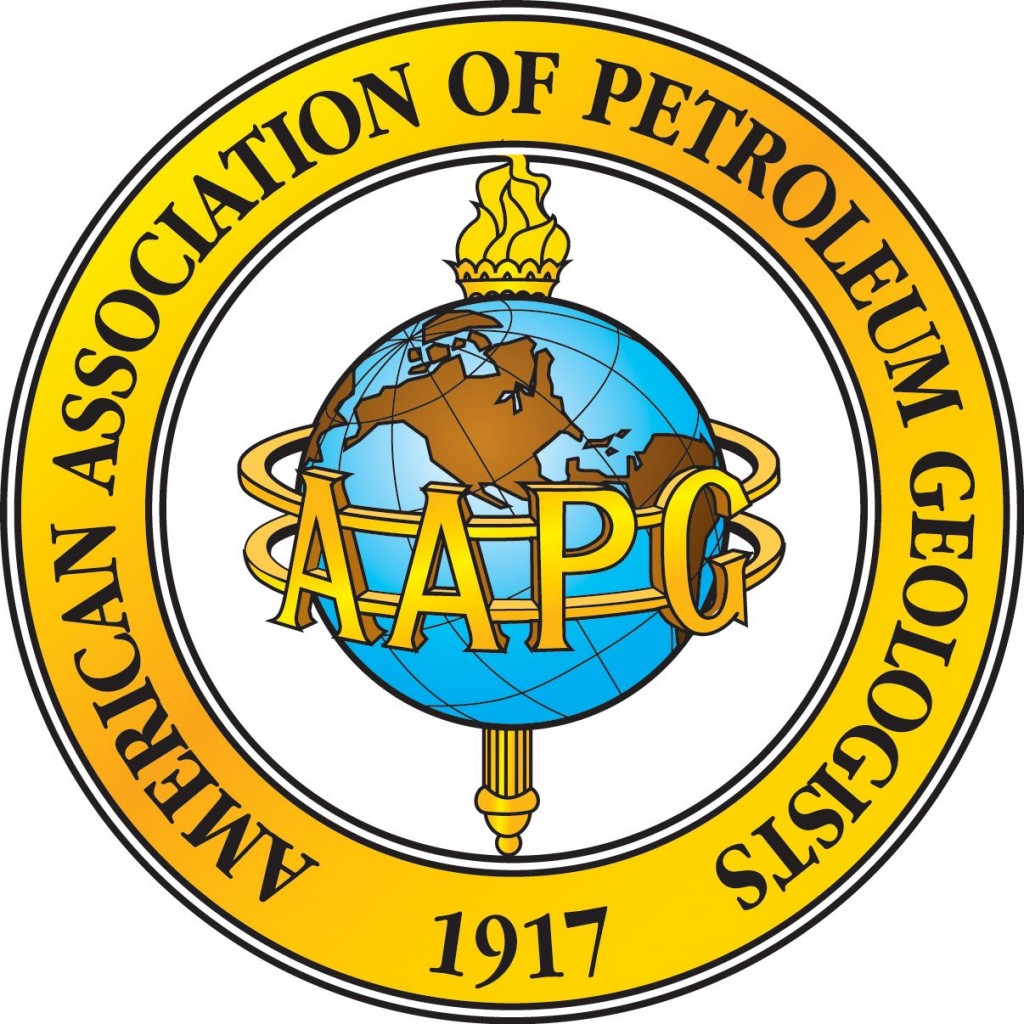
Petroleum geologists celebrated the AAPG centennial in 2017.
Adopting its current name in 1918, AAPG also launched its peer-reviewed scientific journal, the Bulletin. By 1920, industry trade magazines were praising the association’s professionalism and success in combating, “unscrupulous and inadequately prepared men who are attempting to do geological work.”
AAPG in 1945 formed a committee to assist the Boy Scouts of America with a geology merit badge and the AAPG Foundation supports a Distinguished Lecture program. The association’s 2025 membership has reached almost 40,000 members, including 8,000 students, in 129 countries.
Learn more in AAPG – Geology Pros since 1917.

February 10, 1956 – Frank Lloyd Wright’s “Prairie Skyscraper”
Harold C. Price Sr., founder of the pipeline construction company H.C. Price, dedicated his headquarters building in Bartlesville, Oklahoma. The 19-story concrete and copper office tower remains the only skyscraper designed by architect Frank Lloyd Wright.
Established in 1921, H.C. Price specialized in field welding oil storage tanks and electric welding of pipelines. The company helped construct the “Big Inch” pipelines during WWII and built large sections of the 800-mile Trans-Alaska Pipeline.

Once a pipeline company headquarters, the Price Tower in Bartlesville, Oklahoma, was listed on the National Register of Historic Places in 1974. Photo by Bruce Wells.
Wright — who in 1954 designed the Price family residence in Phoenix, Arizona — created the Bartlesville “Prairie Skyscraper” in four quadrants, “based on the geometry of a 30-60-90 degree double parallelogram module” with one quadrant for apartments and three for offices, according to the current occupant, Price Tower Arts Center. The National Register of Historic Places added the former pipeline company headquarters building in 1974.
February 12, 1954 – First Nevada Oil Well
After hundreds of dry holes (the first drilled near Reno in 1907), Nevada became a petroleum-producing state. Shell Oil Company’s second test of its Eagle Springs No. 1 well in Nye County produced commercial amounts of oil. The routine test revealed petroleum production from depths between 6,450 feet and 6,730 feet.
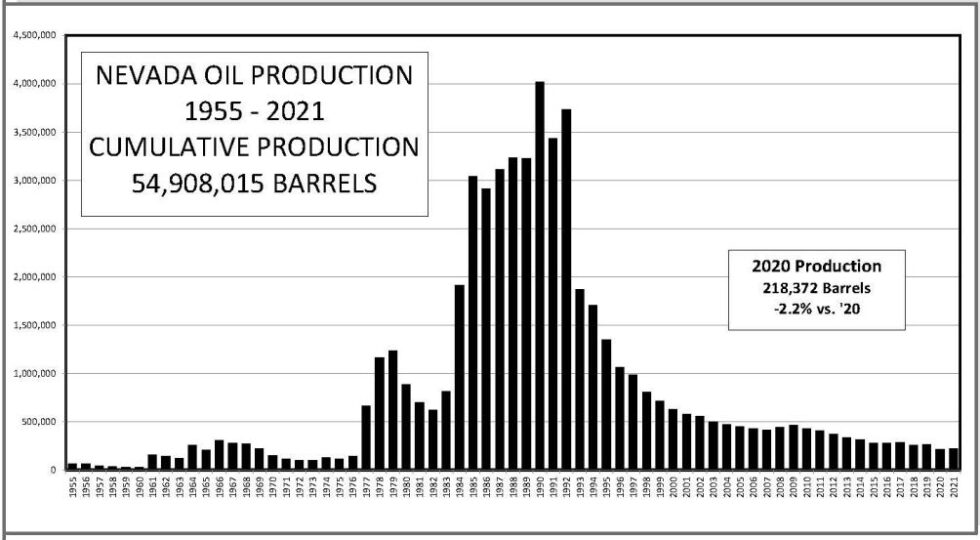
Nevada’s annual oil production peaked in 1990 at about 4 million barrels of oil. Chart courtesy Nevada Division of Minerals.
Although the Eagle Springs field eventually produced 3.8 million barrels of oil, finding Nevada’s second oilfield took two more decades. Northwest Exploration Company completed the Trap Spring No. 1 well in Railroad Valley, five miles west of the Eagle Springs oilfield in 1976.
Learn more in First Nevada Oil Well.
February 12, 1987 – Texaco Fine upheld for Getty Oil Takeover attempt
A Texas court upheld a 1985 decision against Texaco for having initiated an illegal takeover of Getty Oil after Pennzoil had made a bid for the company. By the end of the year, the companies settled their historic $10.3 billion legal battle for $3 billion when Pennzoil agreed to drop its demand for interest.
The compromise was vital for a reorganization plan for Texaco emerging from bankruptcy, a haven it had sought to stop Pennzoil from enforcing the largest court judgment ever awarded at the time, according to the Los Angeles Times.

February 13, 1924 – Forest Oil adopts Yellow Dog Logo
Forest Oil Company, founded in 1916 as an oilfield service company by Forest Dorn and his father Clayton, adopted a logo featuring the two-wicked “yellow dog” oilfield lantern. The logo included a keystone shape to symbolize the state of Pennsylvania, where Forest Oil pioneered water-flooding methods to improve production from the 85,000-acre Bradford oilfield.
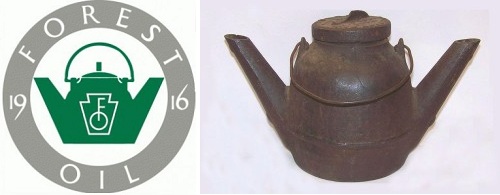
Forest Oil Company adopted the “yellow dog” lantern logo in 1924. eight years after being founded in Bradford, Pennsylvania,
Forest Oil Company‘s oilfield water-injection technology, later adopted throughout the petroleum industry, helped keep America’s first billion-dollar oilfield producing to the present day. Patented in 1870, the popular derrick lamp’s name was said to come from the two burning wicks resembling a dog’s eyes glowing at night.
Learn more in Yellow Dog – Oilfield Lantern.
February 13, 1977 – Texas Ranger “El Lobo Solo” dies
“El Lobo Solo” — The Lone Wolf — Texas Ranger Manuel T. Gonzaullas died at age 85 in Dallas. During much of the 1920s and 1930s, he had earned a reputation as a strict law enforcer in booming oil towns.

Texas Ranger Manuel Gonzaullas’ “working pistols” had the trigger guard cut away.
When Kilgore became “the most lawless town in Texas” after discovery of the East Texas oilfield in 1930, Gonzaullas was chosen to tame it. “Crime may expect no quarter in Kilgore,” the Texas Ranger once declared. He rode a black stallion named Tony and sported a pair of 1911 .45 Colts with his initials on the handles.
“He was a soft-spoken man and his trigger finger was slightly bent,” noted independent producer Watson W. Wise in 1985. “He always told me it was geared to that .45 of his.”
Learn more in Manuel “Lone Wolf” Gonzaullas, Texas Ranger
February 15, 1982 – Deadly Atlantic Storm sinks Drilling Platform
With rogue waves reaching as high as 65 feet during an Atlantic cyclone, offshore drilling platform Ocean Ranger sank on the Grand Banks of Newfoundland, Canada, killing all 84 on board. At the time the world’s largest semi-submersible platform, the Ocean Ranger had been drilling a third well in the Hibernia oilfield for Mobil Oil of Canada.
The deadly weather system also engulfed a Soviet container ship 65 miles east of the platform, resulting in the loss of 32 crew members. A 1983 Coast Guard Marine Casualty Report about Ocean Ranger led to improved emergency procedures, lifesaving equipment, and manning standards for Mobile Offshore Drilling Unit (MODU) operations.

February 16, 1935 – Petroleum Producing States form Commission
A multi-state government agency that would become the Interstate Oil and Gas Compact Commission was organized in Dallas with adoption of the “Interstate Compact to Preserve Oil and Gas.” Approved by Congress in August, the commission established its headquarters in Oklahoma City.

Headquarters of the Interstate Oil and Gas Compact Commission (IOGCC) on property adjacent to the governor’s mansion in Oklahoma City since the 1930s.
Representatives from Colorado, Illinois, Kansas, New Mexico, Oklahoma and Texas began planning initiatives, “to conserve oil and gas by the prevention of physical waste thereof from any cause.” Oklahoma Gov. Ernest W. Marland — founder of Marland Oil Company in 1921 — was elected the first chairman.
“Faced with unregulated petroleum overproduction and the resulting waste, the states endorsed and Congress ratified a compact to take control of the issues,” according to IOGCC, which added the word gas to its name in 1991.
_______________________
Recommended Reading: Black Gold in California: The Story of California Petroleum Industry  (2016); Trek of the Oil Finders: A History of Exploration for Petroleum (1975); Building Bartlesville, 1945-2000, Images of America: Oklahoma
(2016); Trek of the Oil Finders: A History of Exploration for Petroleum (1975); Building Bartlesville, 1945-2000, Images of America: Oklahoma (2008); Roadside Geology of Nevada
(2008); Roadside Geology of Nevada (2017); The Taking of Getty Oil: Pennzoil, Texaco, and the Takeover Battle That Made History
(2017); The Taking of Getty Oil: Pennzoil, Texaco, and the Takeover Battle That Made History (2017); Images of America: Around Bradford
(2017); Images of America: Around Bradford (1997); Lone Wolf Gonzaullas, Texas Ranger (1998); The Ocean Ranger: Remaking the Promise of Oil (2012); Oil in Oklahoma
(1997); Lone Wolf Gonzaullas, Texas Ranger (1998); The Ocean Ranger: Remaking the Promise of Oil (2012); Oil in Oklahoma (1976). Your Amazon purchase benefits the American Oil & Gas Historical Society. As an Amazon Associate, AOGHS earns a commission from qualifying purchases.
(1976). Your Amazon purchase benefits the American Oil & Gas Historical Society. As an Amazon Associate, AOGHS earns a commission from qualifying purchases.
_______________________
The American Oil & Gas Historical Society (AOGHS) preserves U.S. petroleum history. Please support energy education, help maintain the AOGHS website, and expand historical research for scribers to the monthly “Oil & Gas History News.” For more information, contact bawells@aoghs.org. Copyright © 2025 Bruce A. Wells. All rights reserved.
by Bruce Wells | Nov 11, 2024 | This Week in Petroleum History
November 11, 1884 – Gas Companies merge into Con Edison –
The largest U.S. gas utility company at the time was created in New York City when six gas-light companies — using manufactured coal gas — combined to form the Consolidated Gas Company. The Consolidated Edison Company, “Con Ed,” began six decades earlier as the New York Gas Light Company, which received a charter from the state legislature in 1823.

“Bird’s-eye view” illustrates New York and Brooklyn in 1873. The Brooklyn Bridge, then under construction, can be seen at the right. Image courtesy Library of Congress.
Like most early manufactured gas companies, New York Gas Light focused early efforts on public street lighting (see Illuminating Gaslight), replacing whale oil lamps installed by the city beginning in the 1760s.
Prior to the 1884 merger of the competing companies, streets often were being torn up by competing workmen installing or repairing their own company’s lines — and removing those of a rival. “Sometimes these work crews would meet on the same street and brawl, giving rise to the term “gas house gangs.”
Learn more in History of Con Edison.

November 11, 1926 – Route 66 officially commissioned
Five years after the Federal Aid Highway Act of 1921, U.S. Highway 66 was commissioned as a major thoroughfare in the national highway system. America’s “Mother Road” from Chicago to Los Angeles connected rural and urban communities along its almost 2,500 miles — until the interstate system incrementally replaced it.
Extended from Los Angeles to Santa Monica in 1935, Route 66 lost its highway status 50 years later when the American Association of State Highway and Transportation Officials officially decertified it. In 2019, Oklahoma established the Route 66 Centennial Commission, assisted by the Oklahoma Historical Society, to plan events celebrating the historic highway’s centennial in 2026.
November 12, 1899 – New York World features Mrs. Alford and her Nitro Factory
An 1899 article in the New York World profiled Mrs. Byron Alford — the “Only Woman in the World who Owns and Operates a Dynamite Factory.”

A laminated (though wrinkled) newspaper page from 1899 was part of a school project of a Mrs. Alford descendant, according to the Penn-Brad Oil Well Park and Museum in Bradford, Pennsylvania.
Mrs. Alford’s dangerous business operated on five acres outside of Bradford, Pennsylvania, with a daily production of 3,000 pounds of nitroglycerin and 6,000 pounds of dynamite. Local drillers used the explosives for “shooting” wells to boost production.
The article noted “the astute businesswoman” manufactured her volatile mixtures in 12 separate buildings, all made of wood and unpainted.
Learn more in Mrs. Alford’s Nitro Factory.
November 12, 1916 – Forest Oil Company formed
Forest Oil Company incorporated and began operations in the Bradford oilfield of northern Pennsylvania. The company, after adopting a “yellow dog” lantern logo, launched an important new technology: water-flooding (injecting water into oil-bearing formations) to stimulate production from depleted wells.
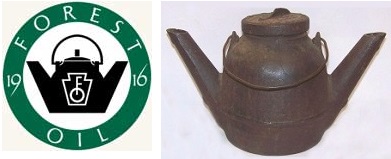
Forest Oil’s “yellow dog” lantern logo beside the oilfield lantern.
Water-flooding technology for enhanced recovery spread throughout the petroleum industry – and extended many wells’ lives by as much as a decade.
After merging in 1924 with four independent oil companies (January Oil Company, Brown Seal Oil, Andrews Petroleum, and Boyd Oil), Forest Oil was headquartered in Denver before being acquired in 2014 by a privately held Houston company.
November 12, 1999 – Plastics designated Historic Landmark
The American Chemical Society designated the discovery of a high-density polyethylene process as a National Historic Chemical Landmark in a ceremony at the Phillips Petroleum Company in Bartlesville, Oklahoma. The oil company had entered the plastics business in 1951 after discovering a catalyst for creating solid polymers.
“The plastics that resulted — crystalline polypropylene and high-density polyethylene (HDPE) — are now the core of a multibillion-dollar, global industry,” the society noted. Among the first customers for Phillips Petroleum plastics was Wham-O, which used it to make Hula Hoops and Frisbees in the 1950s.

November 13, 1943 – Death during Secret WWII Drilling Project
Derrickhand Herman Douthit of Caddo Mills, Texas, died from a fall at Well Number 148 in England’s Sherwood Forest, where he was part of a top-secret group of Americans drilling to expand production from the Eakring field. The roughnecks of Sherwood Forest increased production faster than their British counterparts while working 12-hour shifts in four crews. “Rigs shut down for one shift for his funeral, then back to work,” recalled Lewis Dugger of Louisiana. Forty-one of the volunteers returned safely in March 1944. Douthit was buried near Cambridge with full military honors.
November 14, 1927 – Gasometer Explosion shakes Pittsburgh
Three natural gas containers — gasometers — exploded in Pittsburgh, producing “tremors such as might have been caused by a severe earthquake,” according to a 1927 report, which noted the deaths of 28 people and injury of more than 400.
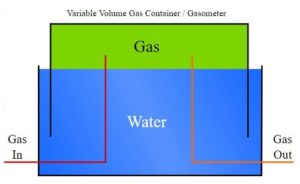
More often found in Europe, gasometers were replaced by high-pressure vessels for liquefied natural gas.
First used in the late 19th century for manufactured gas (and throughout the 20th century for natural gas), gasometers were large, cylindrical containers for storing gas at near atmospheric pressure at ambient temperatures. The volume of stored gas varied, with pressure added from the weight of a movable cap.
According to a 2006 Pittsburgh Magazine article, workmen had been using acetylene torches to repair a leak on top of a tank with a capacity of 5 million cubic feet of gas. Gasometers structures have been replaced by high-pressure vessels to store natural gas in liquid form (learn more in Horace Horton’s Spheres).
November 14, 1947 – First Oil Well drilled Out of Sight of Land
The modern offshore oil and natural gas industry began in the Gulf of Mexico with the first oil well successfully completed out of sight of land. Brown & Root Company built the experimental freestanding platform 10 miles offshore for Kerr-McGee and partners Phillips Petroleum and Stanolind. The platform, Kermac 16, was designed to withstand winds as high as 125 miles per hour.

The Kermac 16 platform was featured in a 1954 Bell Helicopter advertisement encouraging use of helicopters for offshore transportation.
After investing $450,000, Kerr-McGee completed the well in about 20 feet of water off Louisiana’s gradually sloping Gulf coast. The Kermac No. 16 well initially produced 40 barrels of oil per hour.
Kerr-McGee had purchased World War II surplus utility freighters and materials to provide supplies, equipment, and crew quarters for the drilling site at Ship Shoal Block 32. Sixteen 24-inch pilings were sunk 104 feet into the ocean floor to secure a 2,700-square-foot wooden deck. The Kermac No. 16 platform withstood several 1947 hurricanes and tropical storms.
Learn more about offshore technologies in Offshore Drilling History.
November 14, 1947 – WW II “Big Inch” and “Little Big Inch” Pipelines Sold
Texas Eastern Transmission Corporation, a company established 11 months earlier to acquire the World War II surplus 24-inch “Big Inch” and 20-inch “Little Big Inch” pipelines, won ownership of them with a bid of $143,127,000. It was America’s largest sale of war surplus material to the private sector.

War Emergency Pipelines, Inc., in 1942 began construction of the longest U.S. petroleum pipeline construction ever undertaken in the United States — two pipelines spanning 1,200 miles. Photo Courtesy Library of Congress.
By the 1950s, Texas Eastern Transmission converted both oil product pipelines to natural gas, which was needed for the Appalachian region. By the 2000s, transmission would become bi-directional for carrying natural gas from the Marcellus and Utica shale to mid-west markets. The Big Inch Pipelines of WW II were added to the National Register of Historic Places in 1998.
November 15, 1906 – Justice Department seeks Breakup of Standard Oil
U.S. Attorney General Charles Bonaparte filed suit to compel dissolution of Standard Oil of New Jersey. Despite an 1892 court decision ordering the Standard Oil Trust to be dissolved, John D. Rockefeller reorganized it and continued to operate from New York. The Justice Department won the latest suit and Standard Oil appealed to the U.S. Supreme Court, which affirmed the lower court’s decision on May 15, 1911, and mandated dissolution of Standard Oil into 34 separate companies.

November 15, 1952 – Williston Basin produces Millionth Barrel of Oil
The Williston Basin produced its millionth barrel of oil, which came from five fields in three counties in North Dakota, where Amerada Petroleum had launched a 1951 drilling boom northeast of Williston (see First North Dakota Oil Well). By the end of 1952, the Williston Basin’s production reached 356,000 barrels of oil a month.




(2016); Trek of the Oil Finders: A History of Exploration for Petroleum (1975); Building Bartlesville, 1945-2000, Images of America: Oklahoma
(2008); Roadside Geology of Nevada
(2017); The Taking of Getty Oil: Pennzoil, Texaco, and the Takeover Battle That Made History
(2017); Images of America: Around Bradford
(1997); Lone Wolf Gonzaullas, Texas Ranger (1998); The Ocean Ranger: Remaking the Promise of Oil (2012); Oil in Oklahoma
(1976). Your Amazon purchase benefits the American Oil & Gas Historical Society. As an Amazon Associate, AOGHS earns a commission from qualifying purchases.











